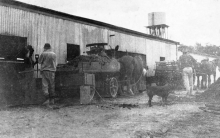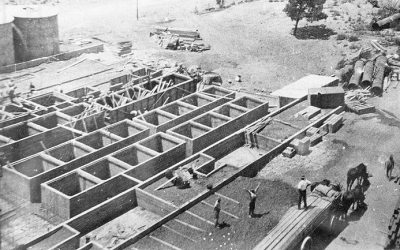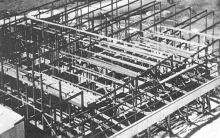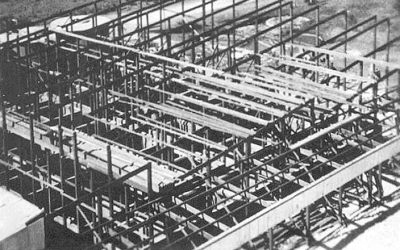 
|
This photo is perhaps vintage 1923 or 1924 with openings for Crushers 1 and 2 in the extended Cellar on each side of the central doorway. The original Water tower can be seen at the rear of the picture and was situated on the west side of the Power House. On the right there appears to be pile of pressed marc and stalks. The growers may have loaded this onto their conveyances to take back to their blocks for fertilising their vines etc..
|
April 13th 1923
Monash, Glossop and Winkie will come into production for the 1924 vintage. Plant can handle 150-200 tons per day. Largest day to date in 1923 is 155 tons. Additions are now being made.
May 25th 1923
Last load on Tuesday 22nd May 1923.
Dec 21st 1923
Dec 18th, Berri Mick Butcher, died of heart attack on last Friday morning. 3 sons, 3 daughters. Eldest Esma, then Gladys and Adelaide. Sons were Laurie, Eric and Charles. Eldest son Laurie, mate on the paddle steamer "J. G. Arnold" missed funeral. Mick was a contractor, horticulturist and owner of the paddle steamer "Ventura."
1924 Vintage Crush 6,823 Tons
February 22nd 1924
Argument regards distilled grape spirit purity.
March 21st 1924
Advertisements for:- Spirit carting to Berri
Return empty hogsheads from Berri
Position as Secretary
Removal of skins and stalks from distillery; approximately 30 tons per day. Signed E.W. Paynter.
Mr. Leslie W. A. Peacock was appointed as Secretary during 1924.
DISTILLERY CARTING
Monash April 27th 1924 To the uninitiated, distillery carting is a very simple and easy job, just driving the vehicle and throwing its contents into a pit-but that is not all. One heard of early morning queues last year but in an endeavour to the two loads in per day, as some carters have been doing, some folks are "on the road" at very early hours.
Record upon record has been broken. One person from Lone Gum was heard starting off at 2.45 a.m. He was the first at the distillery but even then was not there long before a settler from the Berri "flats" came along. Since then one person, carting from Winkie, is credited with having arrived between 2.30 and 3 a.m.. Another case is that of a settler from Monash who attended a dance on Thursday night, went home, had a cup of coffee and then changed, harnessed up and set off for the distillery. One is almost wondering now if the Council propose granting camping licenses to those who might start camping there.
With all the inconveniences of long waiting, however, it is pleasing to see the spirit in which the majority of settlers take things. They fully realise that everything possible is being done by the Distillery Board and their capable General Manager to handle this huge vintage as speedily as possible. Handling a crop of something like 7,000 tons is a solid proposition to face and has to be dealt with systematically and so far this season the quota system is being put into force so as to regulate the quantity of fruit being received each day and to reduce waiting to a minimum.
May 2nd 1924
The Berri Growers' Distillery Berri, April 30th 1924
All roads lead to the distillery these days and the volume of traffic in the immediate vicinity of the building must recall to many old "diggers" the daily visit to the ration dumps-even to the hot coffee stall, except that this is not presided over by a Padre or Salvation Army official, but by a mere blocker, who with true digger instinct has grasped the favourable opportunity and proceeds methodically to amass a fortune.
Yesterday morning at 7 a.m. there were 70 teams waiting to dispose of their loads and it is feared that some early bird will get such a start one morning that he will meet himself on the way home from the previous day's trip. The queue system is (more or less) in vogue, but as the administration of the rules are left to the individual, it is felt that less blood would be shed and fewer descriptive adjectives brought into play if the traffic regulation was in the hands of the police, as is the case at other less congested centres such as Piccadilly Circus, King William Street, etc. There is always with us the "nark" who arrives late but who mysteriously happens to butt in before his turn. One cannot but think that an old time "Cabby" accustomed to the keen competition of the stand would have a good deal in his favour when it came to getting rid of his Doradillo's at the distillery.
November 28th 1924
THE DISTILLERY IMPROVEMENTS
Mr. W. Francis has 45 men engaged working on the extensive distillery extensions. These when completed will cost £40,000. Practically last years additions are to be duplicated as far as the winery goes. Forty 5,000 gallon tanks are to be installed at the back of the new winery. A water tank 66 feet high with a diameter of 28 feet is now in course of erection. This when full will hold 50,000 gallons. It is being constructed of reinforced concrete.
A new warehouse, ( built on the eastern side of the original Bond Store) 120 x 45 feet for storage of spirit is to be put up, and ten 20,000 gallon special tanks are also to be built. Two additional 42 horsepower engines and a large Cornish Boiler will be installed. When completed the distillery will be the largest in the Commonwealth.
  |
Extension of No.1 Ferment Cellar after the 1924 vintage. Out of view on the left of the photo is the west end of No.1 Ferment Cellar that was built after the 1923 vintage and you can see Block 1 roadside 20,000 gallon tanks 101 to 111 that ran from the Main office eastwards to Berri. The last whole tank you can see is Tank 111 and immediately to its right was to be a cone topped tank numbered Tank 112 and this tank pattern was continued with the further block of 21 20,000 gallon tanks. The open tanks are the Skin tanks and in front of these are Crusher Pits 3 and 4. Between the Skin tanks and 20,000 gallon roadside tanks the two rows of Runoff tanks are still to be built. At the mid-right of the photo I believe are sections of the boiler stack for the Babcock and Wilcox boiler. Out of view on the lower right corner of the photo is No.3 Ferment Cellar. At the top there is the Cobdogla road, now the Sturt highway running east west, Battams road on top left and Winkie road turn off by the pine tree. Road to Berri township continues at top right of the photo.
|
  |
Frame work for the asbestos roof at the east end of No.1 Ferment Cellar and you can see at the eastern side of the structure, bases for the Block 1 20,000 gallon tanks and timing would be late 1924. Roadside Tanks 110 and 111 are shown mid left. Tank 112 and the balance of Block 1 Tanks were cone topped as mentioned above.
With reference to the Annual general meeting reports and articles in the Murray Pioneer I have tried to decide the order of construction of the general storage tanks of 20,000 gallons capacity. At the end of 1923 there were 20 of these. The above photo shows 11 tanks along the highway and some foundations for the group of 20,000 gallon tanks. The 1924 annual report said that storage amounted to 360,000 gallons. This equates to 18 tanks of 20,000 gallon capacity. So by this stage there were 12 roadside tanks and 6 in the area east of No. 1 Ferment Cellar.
|
The Manager's house was built this year and was eventually bounded on the east and west sides by two blocks of 20,000 gallon tanks known as Block 4. Auditors entry on 10th December 1924 noted cost of £800 for the residence. |











